HOW INDIA INFLUENCED PORTUGUESE FOOD
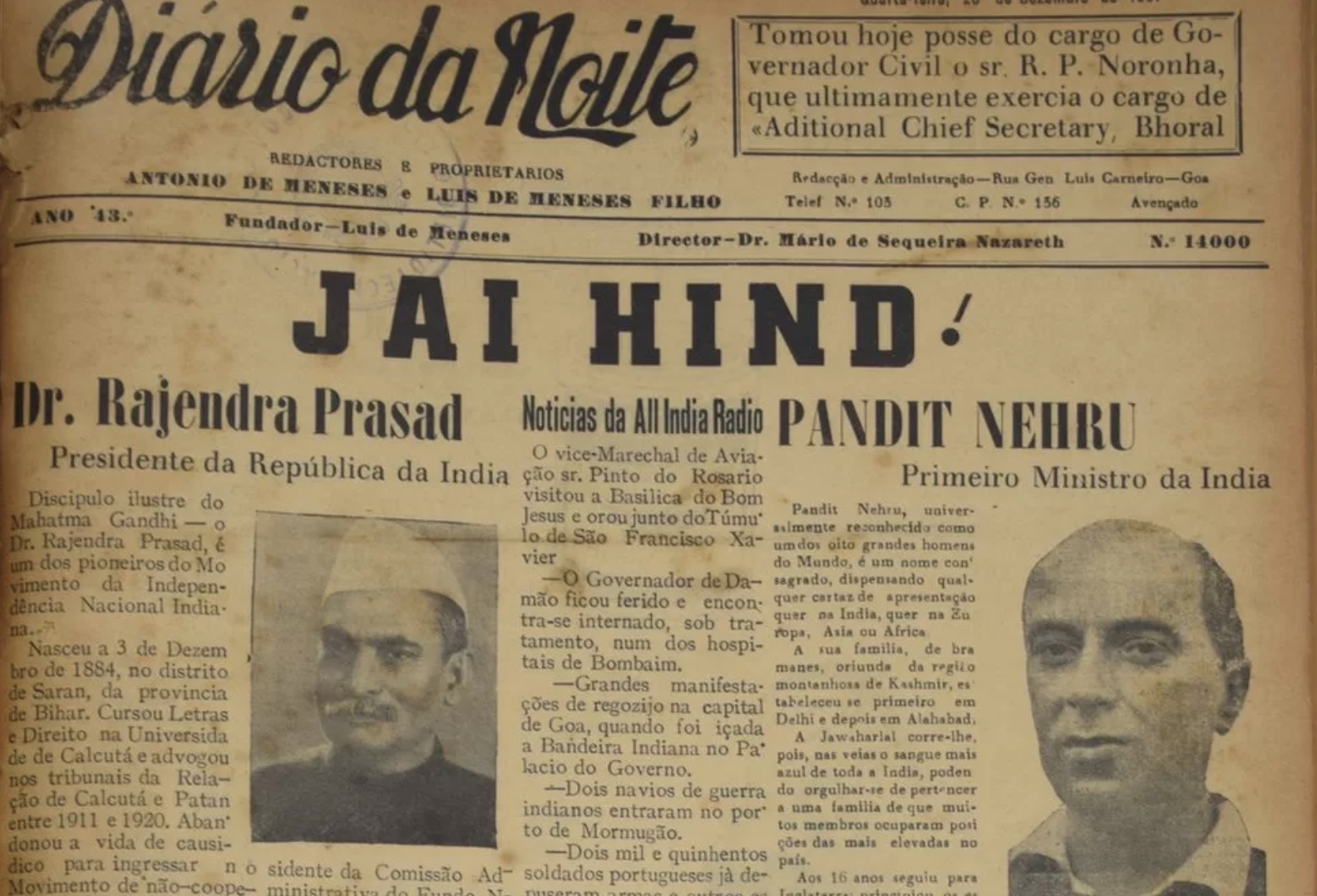
Amongst the world cuisines which the Portuguese have influenced the most, we find Indian cuisine.
But, human relations are rarely, if ever, unilateral, and so India has left and keeps leaving, a tremendous mark in Portuguese culture, namely when it comes to food.
A taste of India in Portugal: colonialism, migrations, spices and other foods
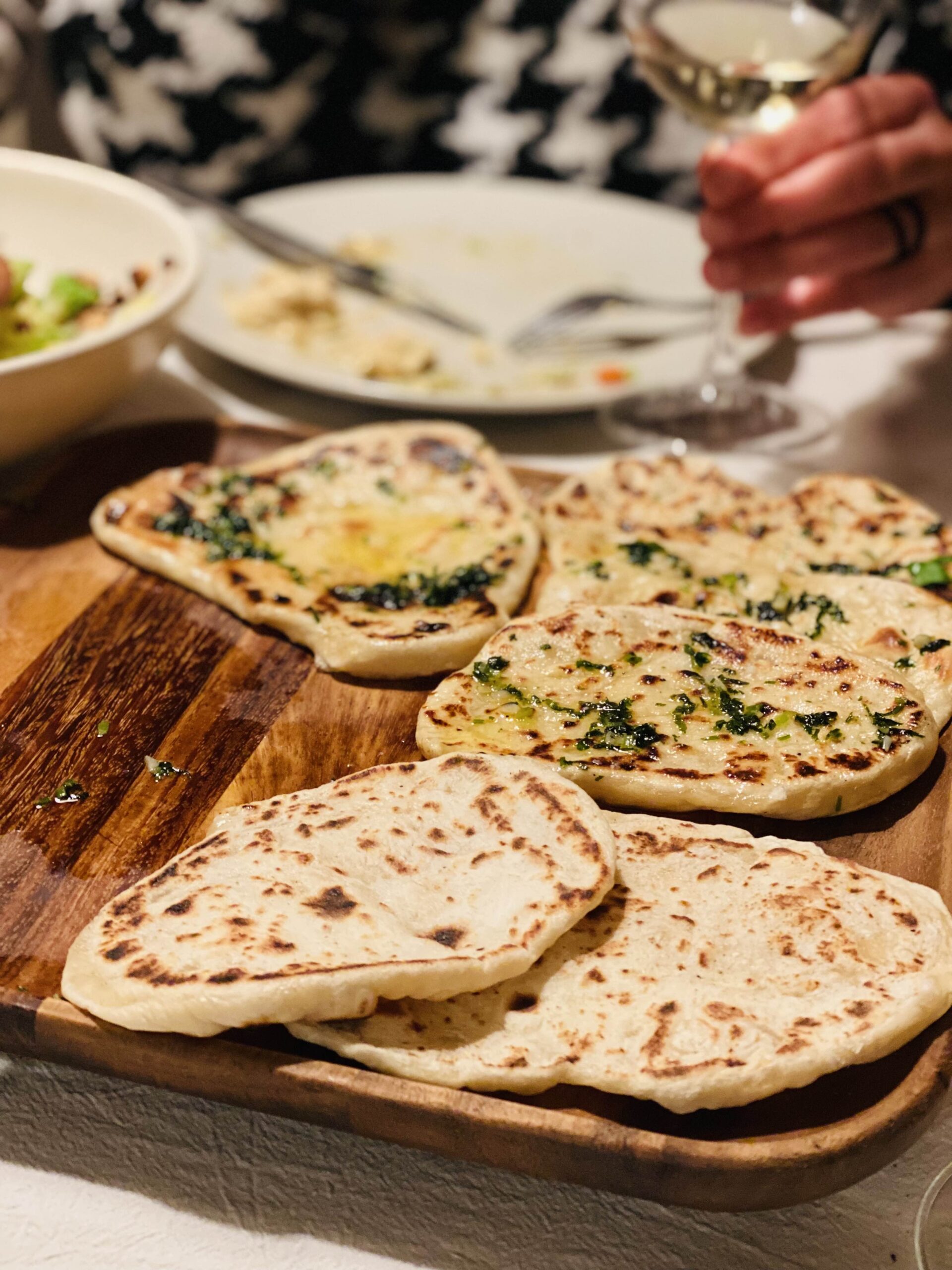
Home made Naan, by Zara, during a diner with friends.
When Vasco da Gama first reached India and eventually came back to the Old Continent, of course he brought back with him a much coveted range of spices, and so did the Portuguese sailors and rulers who came afterwards and who eventually founded Portuguese India. Europeans weren’t unaware of these spices but as the trading routes became busier and spices more broadly available, of course this impacted the way Portuguese folks were cooking until that point in history.
The introduction and generalization of Indian products in Portugal could be observed as having three major different historical periods:
- Firstly, it was from the early 1500s onwards, with Portuguese rule over Goa.
- Later on, when Goa became a part of India, in 1961, Portugal granted the option of citizenship which many Goans accepted
- Finally, Indians kept influencing Portugal, with the migratory movements of Indians, and Mozambicans of Indian descent, when Portugal left its until then colony of Mozambique, in Africa, in 1975.
During the more than 400 years of Portuguese rule in Goa, the Portuguese became used to having access to spices. Initially, these were so prized that they only made it to the cooking pot of rulers and rich families who’d use an indiscriminate amount of savory and sweet flavors, even mixing in the recipes sugar brought over from Brazil and Madeira.
As spices became more affordable, their appeal for the upper classes started diminishing, yet there are spices which have stood the taste of time (and trends) in Portugal and are today such crucial elements of our cuisine. We can’t conceive any given savory Portuguese dish without pepper, for example, or many of our desserts without cinnamon. Today, we incorporate other Indian spices in our cooking, but there’s no doubt that the Portuguese generally do so in a more shy and controlled manner than Indians.
In the 20th century, Goan intellectuals were known to come to Portugal to further their education in Europe. The most relevant migration movement happened after the annexation of Goa by India, in Dezember of 1961. Many Goans were offered the possibility of obtaining Portuguese citizenship (a privilege which was extended mostly to government workers and the military), something they took Portugal upon and keep doing so today when possible, oftentimes in order to take advantage of the possibility of living not in Portugal per se, but in border-free Europe.
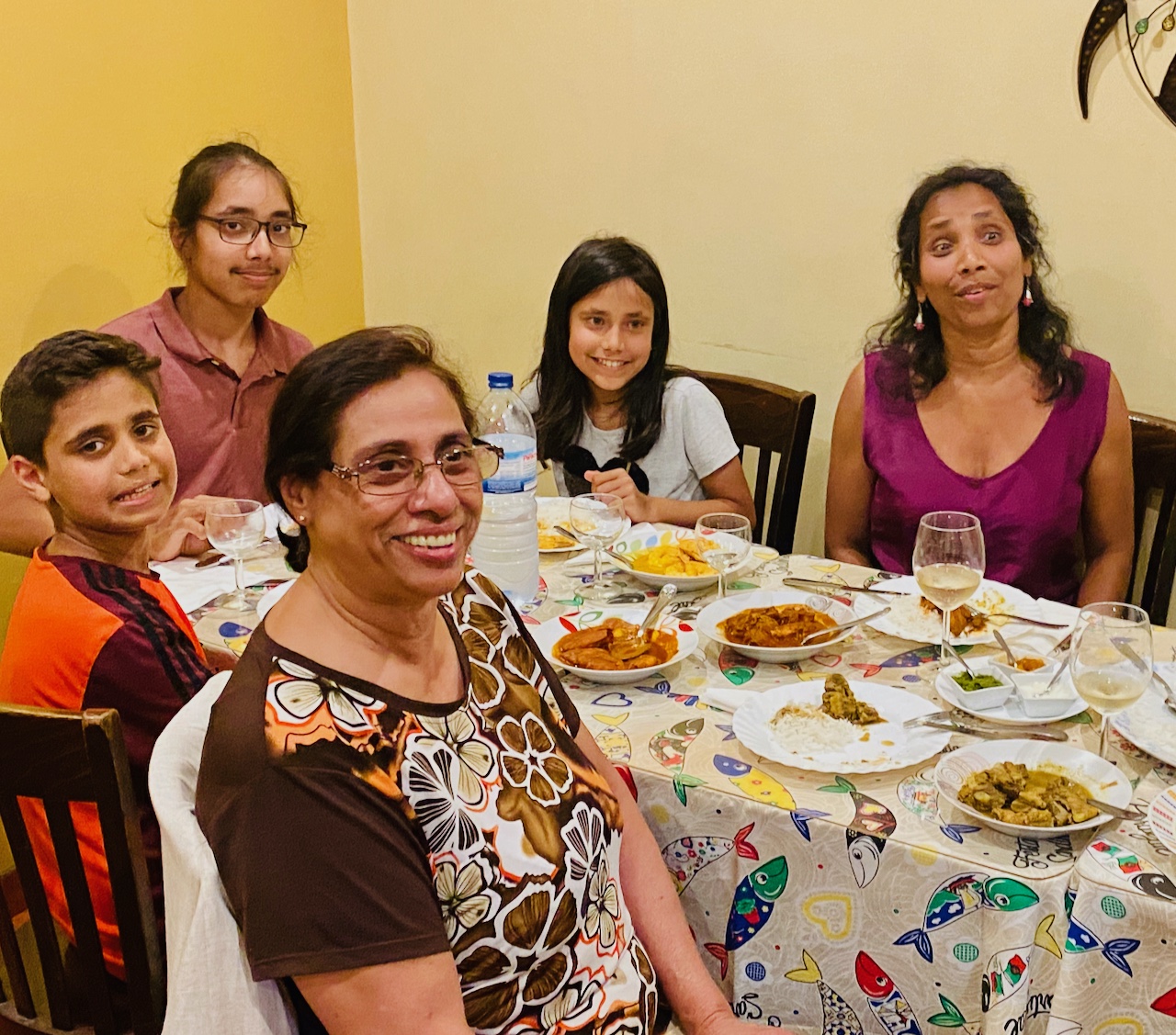
Goan friends living in Munich, during a trip to Lisbon, at Zuari Goan restaurant.
Others who didn’t wish to become a part of India, mostly because of the dominant Hindu religion and fearing becoming a minority, moved to Mozambique. Note that some years before, in 1947, during The Partition of the British Indian Empire, India had already showcased the animosity between Hindus and Muslims, which led to the separation of the country and the founding of 2 other muslim countries, Pakistan and Bangladeh – of course much could be written about the British malevolent influence which instigated such hostility.
In the late 1900s, the Indian community in Lisbon grew exponentially, with families coming over directly from India or via Mozambique. Mozambican-Indians are mostly of Gujarati descent, unlike the Indians who came directly to Portugal, who are Goans. The reasons why there was such a large Gujarati community in Mozambique had its inception in Vasco da Gama’s first trip, when the Portuguese first started settling in Mozambique and doing trade in the Indian Ocean, and also later on, as recently as the 1900s, as Gujaratis went over to Mozambique to work for large firms (coming either directly from India or even via South Africa).
Today, we can count over 25,000 Indians living in Portugal but Indian culture sure had and keeps having more impact than these numbers would anticipate, as there are many, many inhabitants who do not add up to this statistic as they are officially Portuguese (from Mozambique and Goa – even including Portugal’s Prime Minister António Costa, whose grandfather was from Goa!) but who undoubtedly have brought with them a set of customs, traditions and flavors who have greatly contributed to make Portuguese culture more eclectic, richer, varied and, allow us to say it, even tastier!
When it comes to food and the generalization of heavily condimented spicier flavors, we ought to thank not only Indian descent Portuguese, and Indians who now call Portugal home, but also other individuals from the Indian subcontinent, such as Pakistani, Bangladeshi and Nepali, which have lots in common with India and indian cuisine and, in more recents years, have been contributing to the popularization of their bold flavors across Lisbon and beyond.
 How Portuguese food has been impacted by India
How Portuguese food has been impacted by India
Samosas are the perfect snack which embody the impact India has had in Portuguese food. To the surprise of some readers, samosas aren’t fully Indian, but have instead evolved from Persian sambosag. Now-a-days, it’s not at all uncommon to find samosas, or better yet chamuças, in Portuguese cafes, along other local specialties such as cod fish fritters and rissoles. Samosas are so common in Portugal that chances are some locals do regard them as nearly Portuguese. But of course we ought to thank Indians for this incredible fried snack. The samosas you find in Portugal are usually stuffed with meats, such as chicken (chamuça de frango) or beef (chamuça de carne) and clearly speak of the catholic background of the Goans who came to Portugal. In the vast majority of the Indian territory, samosas are filled with spiced potatoes and peas, as per the vegetarian principles of the Hindu majority.
Peixinhos da horta, aka green bean tempura, are another curious example of traditional Portuguese food which may have an Indian influence. These vegetable fritters have been broadly coined to be at the inception of Japanese tempura, when the Portuguese went to Japan in the early 1500s and tried to imposed the catholic beliefs which dictated meat wasn’t to be consumed on fridays – deep-fried vegetables were a satisfying alternative for these days!
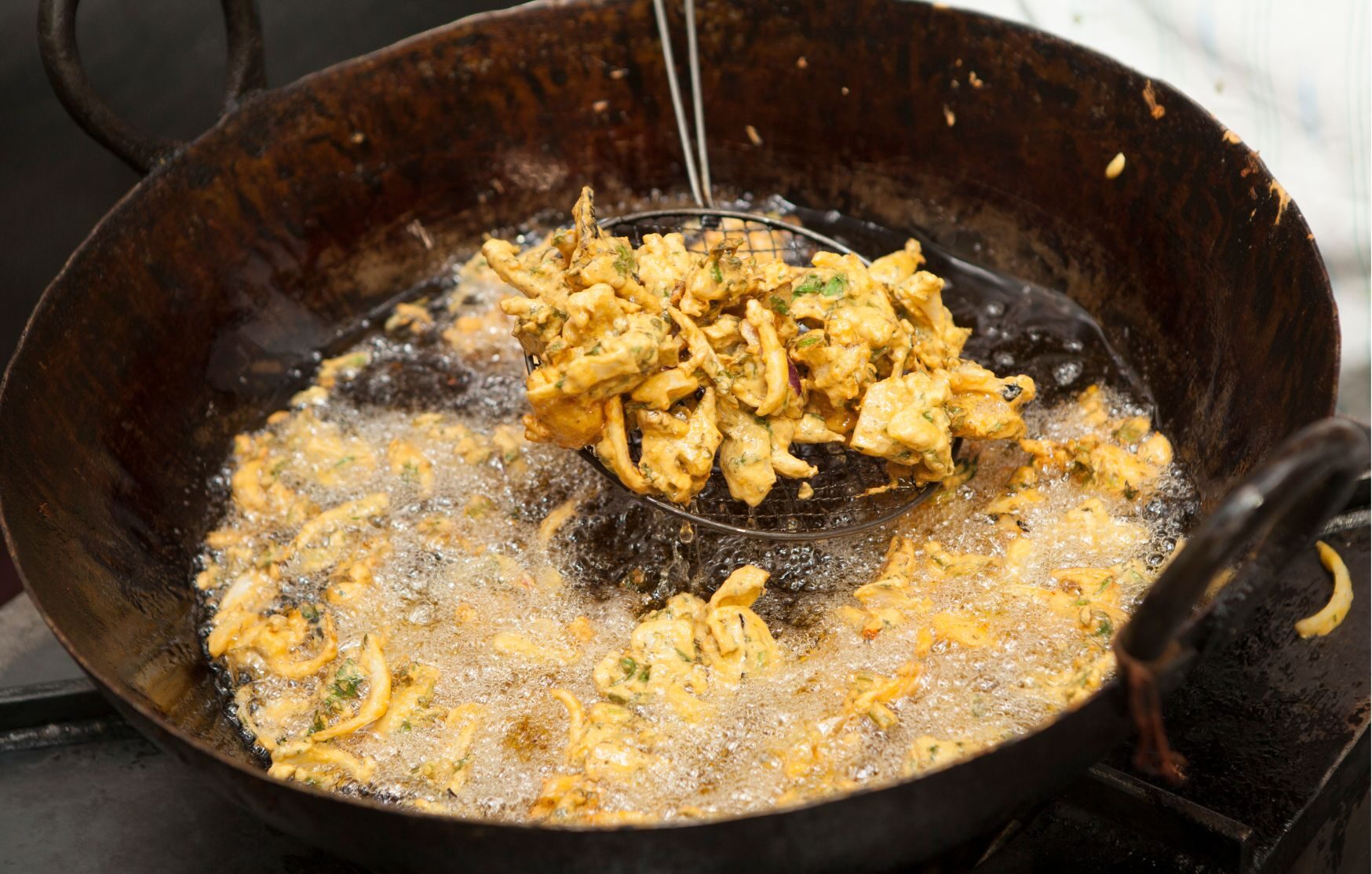
Frying ‘pakoras’
But some currents of thought support that the Portuguese didn’t invent the technique of battering and deep-frying which gave origin to tempura. Instead, they would have already observed how Indians did something similar to this while preparing pakoras (which are vegetables coated with a spiced batter and deep-fried), and simply adapted it according to their taste and more common ingredients.
If Goan Catholic cuisine was influenced by the Portuguese, as we explored in our previous article this influence bommeranged back to Portugal. Some traditional dishes like xacuti or sarapatel are now, often, prepared incorporating a more adventurous use of spices, even though we tend to refer to these dishes as Goan or at least Goan-Portuguese, more than Portuguese. But, once more, we’d like to present a case for how cuisines (just like cultures as a whole), no matter how deeply rooted in tradition they seem, are never stagnant and can always keep embracing new aspects such as ingredients and techniques.
Indian food scene in post-colonial Lisbon
Even though we have been talking about Indian cuisine, the truth is that, in many cases, we could be referring to it as sub-continental cuisine.
Until the Partition of India in 1947, when India, Pakistan and Bangladesh became separate countries, we could have spoken about Indian cuisine as a whole without hurting political sensibilities. If there’s no doubt that the cuisines of these three countries share a lot of commonalities, it’s also true that the entire sub-continent can’t be regarded as having one cuisine. Not even India alone has one given culinary identity, as the country has 28 different states, each with their own idiosyncrasies, peculiar cultural aspects (often shaped by the predominant religion and its given subcultures) and, of course, food habits.
Best Indian restaurants in Lisbon (and other unexpectedly delicious and authentic finds!)
It happens in a considerable number of cities around the world that, when foreign people think of Indian food, their concept may be limited to Punjabi or generally north India dishes of Mughlai background (even though most public isn’t usually aware of this), as a lot of the restaurants which open abroad do indeed focus on the rich cuisines of these parts of India.
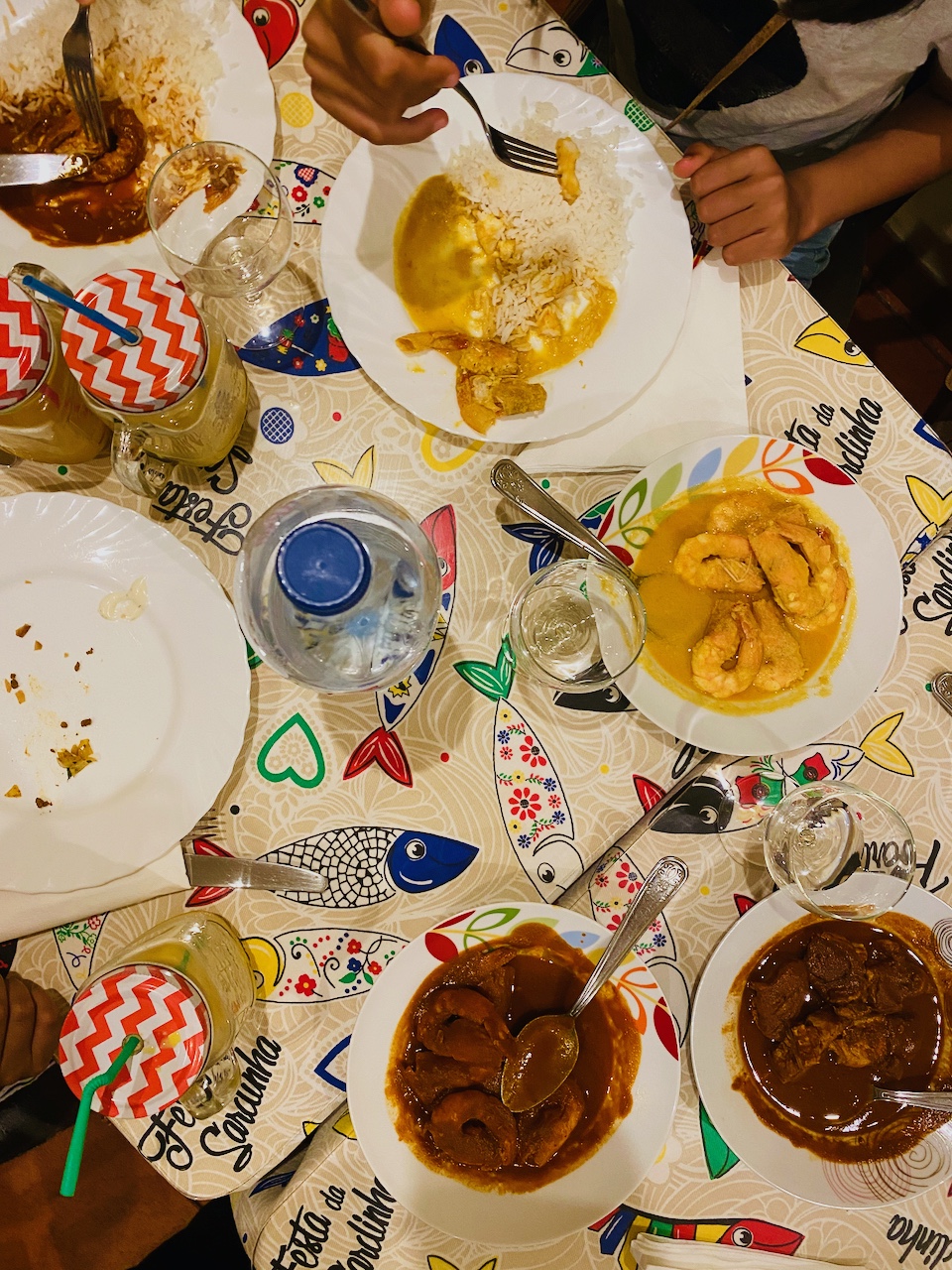
Zuari table during a diner with friends
In Lisbon, because of the historical links, we encounter a good number of Goan restaurants, which often showcase the dishes we talked about above, which came about from the blend of Portuguese and Indian cultures after the 1500s. Besides north Indian and Goan cuisines, in Lisbon we can in more recent years also taste Bengali cuisine, not thanks to the Indian diaspora as such, but as a consequence of the Bangladeshi migration to Portugal which started mostly in the 90s and has been rapidly increasing ever since.
Here in Lisbon, it’s not uncommon for restauranteurs coming from Pakistan, Bangladesh and even Nepal to open establishments and market them as serving Indian food, as they understand that the local population will be more familiar with the idea of Indian cuisine and, as such, the likelihood of them becoming customers would increase as compared to if they’d announce that they serve dishes from their respective countries – which Lisbon diners may be more broadly unfamiliar with. Ultimately, we’re talking about subcontinental cuisine which, once again, showcases major variations from region to region but has lots of things in common too.
In the panorama of Indian and subcontinental restaurants in Lisbon we can, loosely speaking, find four different types of eateries:
- Generic Indian restaurants (more often than not with a mostly north-Indian menu, but not necessarily identified as such);
- Goan restaurants;
- Regional Indian restaurants;
- Other subcontinental restaurants offering Indian cuisines, or a mix of Indian and other countries, such as Pakistani, Bangladeshi and/or Nepali (see Gurkha, with several locations across Lisbon).
For several decades, going out to eat Indian food in Lisbon was associated with a fairly budget friendly dining experience. Unlike it has historically happened in places with large numbers of Indian immigrants (like for example the UK, many parts of the USA or Canada), with some exceptions, most Indian restaurants you’d find in Lisbon weren’t initially opened with the idea of catering to their own communities. As such, it wasn’t at all rare for flavors to be adapted to the average Portuguese palate, with the level of heat toned down and a more shy use of spices.
Today, it is more common to find Indian restaurants in Lisbon which put together dishes which more closely follow traditional flavors and that could, as such, be considered more authentic. This has a lot to do with the fact that eating out has become more of a hobby and interest in international cuisines, particularly among millennials, keeps increasing.
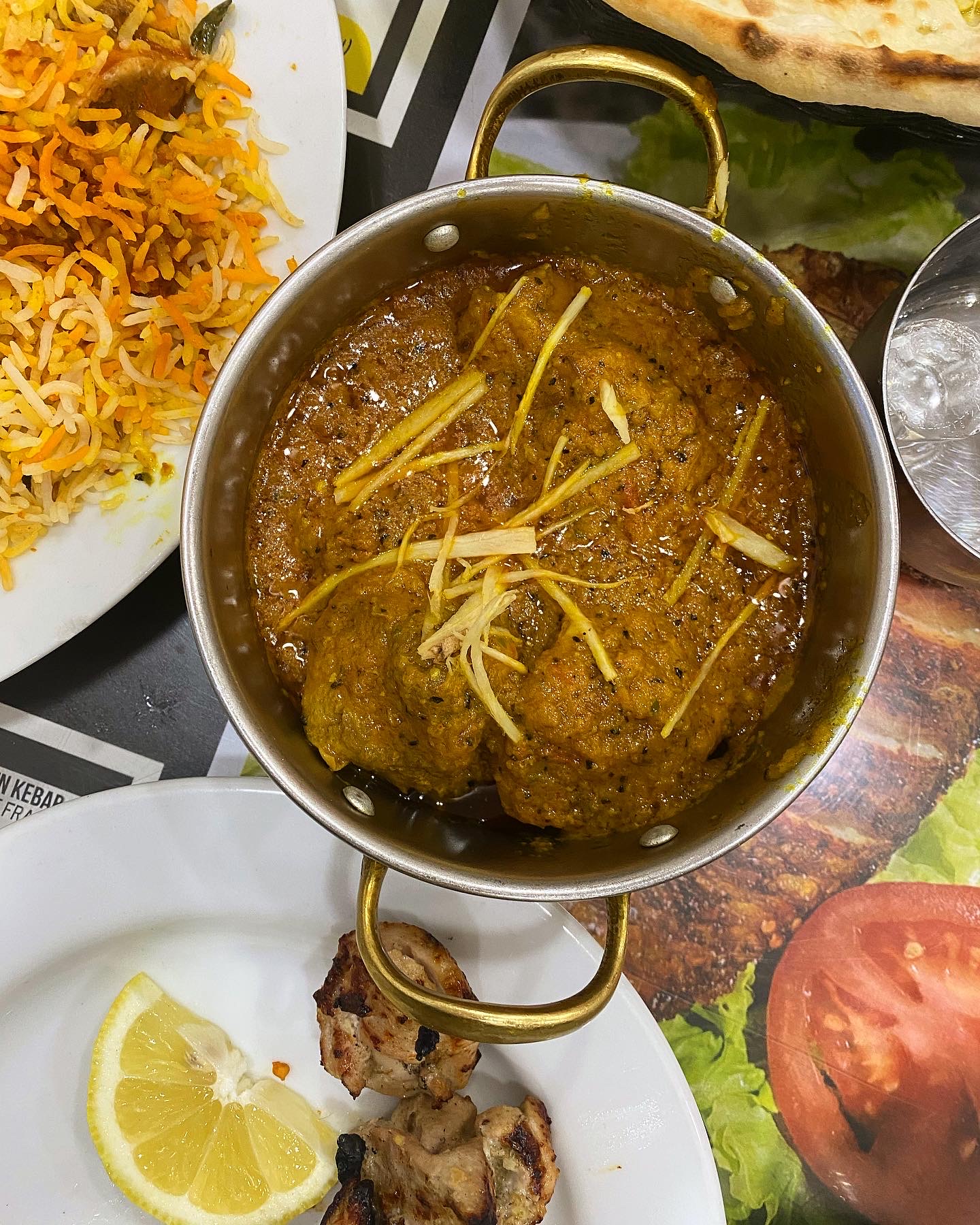
Lamb Karahi at one of the restaurants on Benformoso Street
Examples of good Indian restaurants in Lisbon include India Gate (Rua da Padaria 18) with a focus on north Indian cuisine without leaving Goan bebinca out for dessert as an obvious choice for Portuguese folks; Swaagat The Taste of Indian (Rua dos Correeiros 122-128) for fairly obvious but not because of that any less good Indian dishes; Shree Ram (Av. Duque de Ávila 11-13) for a Punjabi influenced menu with lots of street foods, all vegetarian; Caxemira (fairly hidden at Rua dos Condes de Monsanto 4, 1t floor) for some of Lisbon’s most legendary samosas; and Masala Kraft (Rua Dr. Gama Barros 15A) for deep-rooted Indian dishes with a subtle modern twist.
As mentioned, when an Indian restaurant in Lisbon doesn’t mention a specific region, we could more often than not assume that it focuses on north Indian cuisine, particularly Punjabi – if this is the experience you are literally looking for, visit Taste of Punjab (Beco dos Surradores 18). But what if you’d like to savor the dishes of other Indian regions? In the past decade or so, Lisbon’s restaurant scene has been expanding so much that it now includes nice eateries such as Kerala (Rua Passos Manuel 14) often highlighted as Lisbon’s best south Indian food destination; Costa do Malabar (Rua Rosa Damasceno 6A) for traditional south Indian cuisine (great for dosas!); and Bengal Tandoori (Rua da Alegria 20) for west Bengali dishes.
Beyond the world of restaurants, the canteen of the Hindu temple of Telheiras (Alameda Mahatma Gandhi) is also a prime spot to taste bonafide Indian food, in this case home-cooked style meals from Gujarat, where the cuisine is predominantly vegetarian precisely because of the religious influence. Still within the world of religious temples, it’s worth pointing out that the Gurdwara Sikh Sangat Sahib (Rua José Duarte Lexim 6, in Odivelas, just outside of Lisbon) also serves langar, a complimentary community meal that Sikh temples usually provide for anyone visiting their temple, whether you follow the same beliefs or not, and regardless of your socio-economic or ethnic background.
If you travel to Lisbon and you’re used to eating Indian food back where you come from, it may not be worth it to explore these restaurants. But it could still be a good idea to taste what Goan cuisine is all about! After all, the number of Goan restaurants in Lisbon is fairly high and, not only the large number denotes a softness of local folks for the flavors of Goa, we can safely presume that the competition is healthy thus promoting a high quality experience. If you’re interested in Goan cuisine while in Lisbon, we’d encourage you to visit Segredos de Goa (with locations in Campo de Ourique and Marquês de Pombal) for ambotik and other complex fish curries; Zuari (Rua de São João da Mata 41) for an incredible xacuti or vindaloo; Cantinho da Paz (Rua da Paz 4) for veal pulao; or Tentações de Goa (Rua de São Pedro Mártir 23), which is a true classic of Goan food in Lisbon.
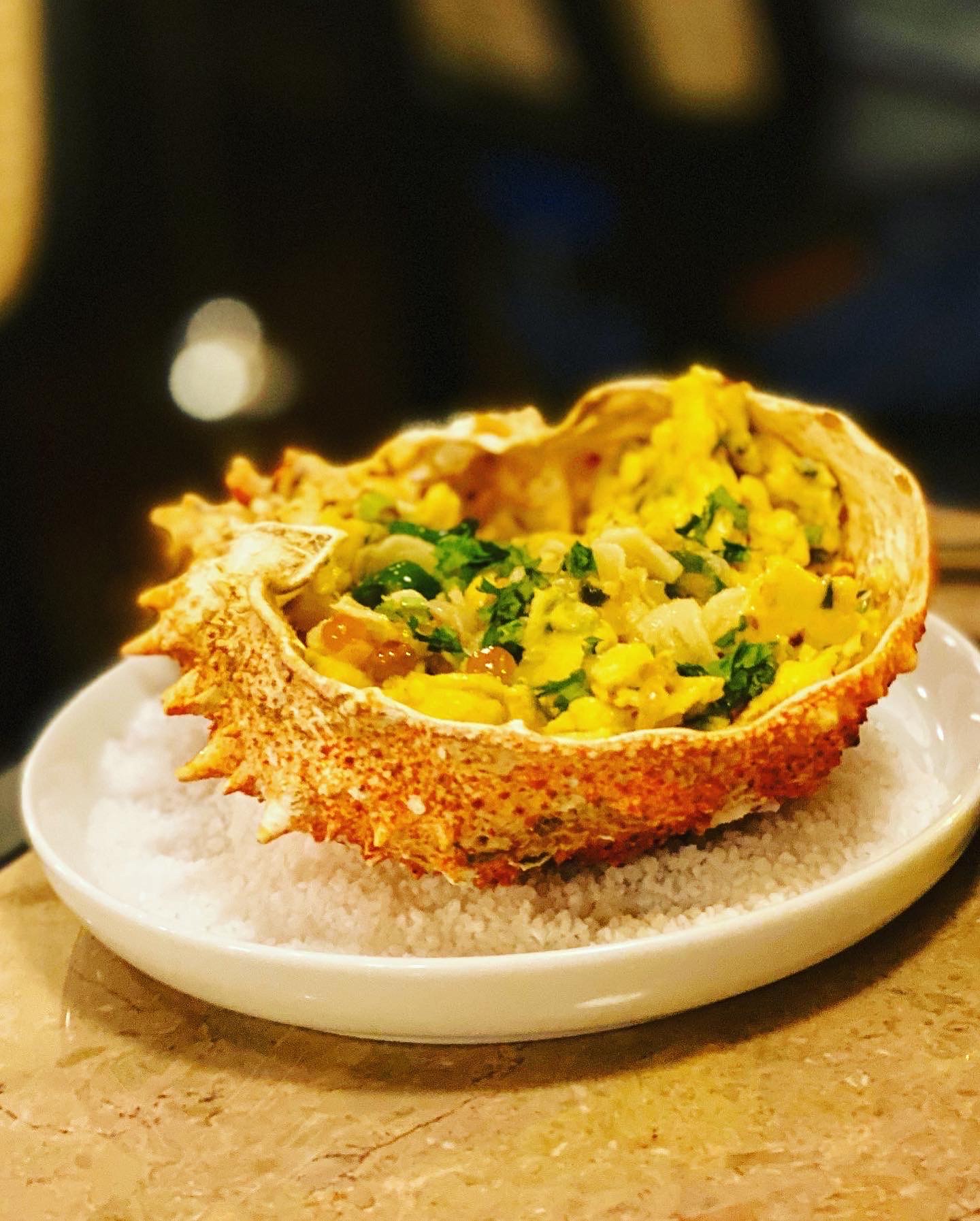
Gunpowder, Michelin Bib Gourmand group of Indian restaurants in November 2022, in Lisbon. Here, one of the seven tastings menu we tried: spider crab egg bhurji with salmon caviar.
To explore sub-continental food in a more broad manner, we’d suggest visiting the eclectic neighborhood of Mouraria, more specifically Rua Benformoso and some of the streets surrounding this artery. Rua Benformoso has been referred to by some as Lisbon’s Little Bangladesh but it’s much more than that!
Here, not only you’ll find Bangladeshi restaurants (some of them offering Bangladeshi and Indian – usually Bengali – cuisines under the same roof), you’ll also find Pakistani eateries, Indian sweet shops, specialized grocery stores, halal butchers and stores selling other staple products of the sub-continental kitchen (karahi cooking pots, masala dabbas, tawa pans, and so much more). The difference between the establishments you’ll usually come across Rua Benformoso (and Mouraria area as a whole) and the rest of Lisbon has to do with the fact that these are, more often than not, no-frills eateries which were open to cater to the communities from the same background. Of course anyone can (and should!) come here for a meal, but the fact that the menus were developed keeping fellow country people in mind usually translates into not only having genuine flavors, but also presenting pretty specific dishes. You wouldn’t come to Rua Benformoso to order chicken tikka masala – of course you can do this, but why would you when there’s so much more to choose from and expand your preconceived idea of what these subcontinental cuisines are all about?
In striking contrast with the affordable restaurants you find in and around Rua Benformoso, which generally speaking cater to the working class, modern day Lisbon is lucky enough to see new contemporary Indian restaurants pop up – pleasing not only Lisbon diners but also the growing international community that has been settling in Lisbon making it a more international city with growing demands, in many fronts, including the dining scene! Contemporary casual Indian restaurants offering a more refined experience than most here in Lisbon include Cinnamon (Rua de S. Paulo 27-31), which has adapted a typical Indian menu to cater to local eating habits focusing on Indian tapas with a twist; Chutnify (Travessa da Palmeira 44) taking Indian food to a whole new kitsch-meets-trendy level; and the more recent Gunpowder (Rua Nova da Trindade 13), with a product focused kitchen which transforms Portuguese products with traditional Indian cooking techniques.
How to taste the encounters between Portugal and India in Lisbon today
If by now it’s clear how Portugal influenced Indian cuisine and how India, meanwhile, has also influenced Portuguese food (as far back as the 1500s, but also in recent decades due to more contemporary migratory influxes), it would also be interesting to understand how these two cultures have come together in contemporary forms of expression. We know Indian vindaloo derived from Portuguese vinha d’alhos, and that you can eat samosas in just about any given Portuguese cafe. This is an exchange, but not exactly a blend of cultures.
Captivatingly, we can indeed find examples of how new dishes came into existence, as a consequence of these cultures coming into contact, but mostly thanks to the creativity of cooks who have absorbed inspiration from the best of both worlds and put it all out in the form of brand new signature dishes. If you are interested in this cross-cultural medley of Indian and Portuguese cuisines, travel to Lisbon and book a table at Jesus é Goês (Rua São José 23), where chef-owner Jesus Lee Fernandes, originally from Goa, crafts miraculous dishes like shrimp samosas, goatling xacuti and pork sarapatel. The merging of India and Portugal in Jesus é Goês’ menu is best identified with dishes such as mushroom and chestnuts xacuti, where chef Jesus takes a curry usually prepared with chicken, lamb, or beef and turns it into a vegetarian version with chestnuts, a very common ingredient in Portuguese comfort cooking; but also dogfish ambotik, a sour fish curry here prepared with cação, an Atlantic type of shark particularly relevant within the realms of the traditional cuisine from the Alentejo, as embodied in the rich soup sopa de cação. Jesus’ menu keeps changing, containing Goan classics which make his Goan-descent customers happy, but also daring to embrace the idea that cuisines, just like cultures, are an ever-changing phenomena. This materializes in more bold creations which keep more adventurous diners coming back for more, and that make us hopeful for a new exciting future of Goan food and, above all, to solidify the concept of Goan-Portuguese cuisine laying on solid traditional basis but reaching for beyond the obvious legacy we usually get to experience and taste around Lisbon.
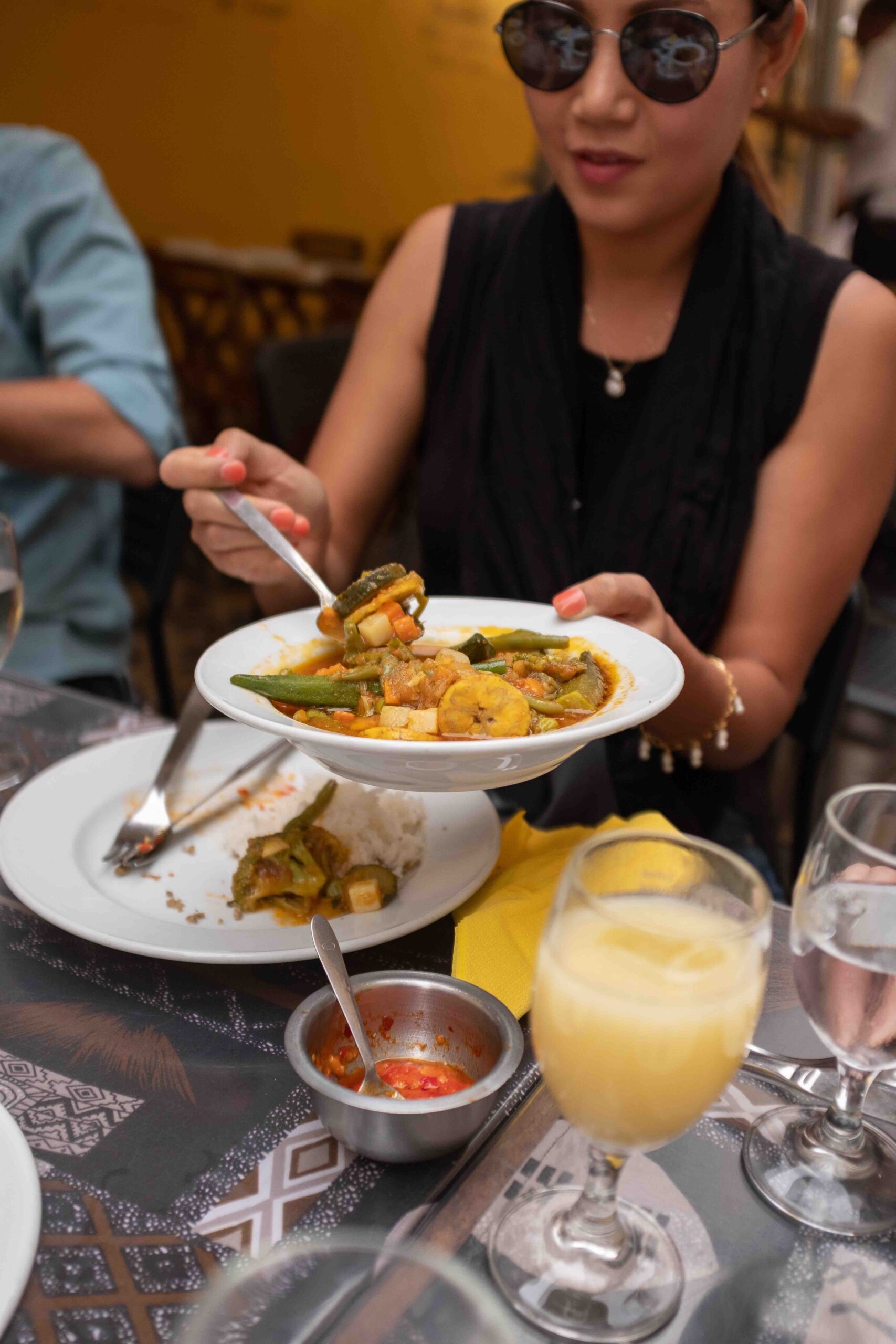
Massamba dish at Cantinho do Aziz during one of our food expeditions
Indian influenced contemporary Portuguese food also has a place in Lisbon’s medium to upper scale dining scene. Celebrated Michelin-starred chefs such as José Avillez (particularly at his Cantinho do Avillez) and Henrique Sá Pessoa, are known to incorporate subcontinental influences on their gastronomic creations, and so do recently opened restaurants such as Kohima (Pátio Das Fragatas, Av. Boa Esperança), where you could taste lombo de bacalhau com caril à Vasco da Gama, a dish of salted cod loin with curry aptly named to catch the attention of diners curious to taste contemporary Indian-Portuguese food.
Yet if there is one contemporary chef in Lisbon who has mastered the art of including elements of parts of the world where the Portuguese have had an historical presence at, including India but not limited to it, that is André Magalhães, popularly known as Mestre André, who is a food writer, chef and owner of Taberna da Rua das Flores (Rua das Flores 103). Even though Taverna da Rua das Flores’s menu keeps changing according to seasonality and strikes of creativity (or should we say pure genius?) it always makes it a point to make us travel through our sense of taste. Think of a vegetable curry with a cream of requeijão, a Portuguese cottage cheese; rayfish rava-fry with green mango chutney; or Goan tuna croquetes, and you might start getting the idea of what we’re talking about!
Visit an African restaurant to eat Indian food in Lisbon
One of the unique aspects of Lisbon’s dining scene is that, to taste Indian food, you could actually visit an African restaurant!
We have explored above how Indian descent communities made their way to Portugal via Mozambique. This Indian-Mozambican diaspora, with predominantly Gujarati background, eventually came to settle in Lisbon, particularly after Portugal detached its African colonies as recently as in 1975, right after our dictatorial regime came to an end.
To taste Indian-African Portuguese welcomed food in and around Lisbon, we recommend visiting restaurants such as Cantinho do Aziz (Rua de São Lourenço 5) which has legendary samosas; Oliveira’s (Rua Dr. António Cândido 15) which makes a mean crab curry; or Bula Bula Mozambique Soul (Rua Sebastião da Gama 4A 2650, Casal de São Brás – Amadora) where the bebinca is a sweet work of beauty!
The future of Indo-Portuguese cuisine
Times change and the creativity of cooks, now living in this globalized world where diners are always eager to try new things (from other places or as invented “from scratch” as possible), makes the repertoire of gastronomic creations virtually never ending.
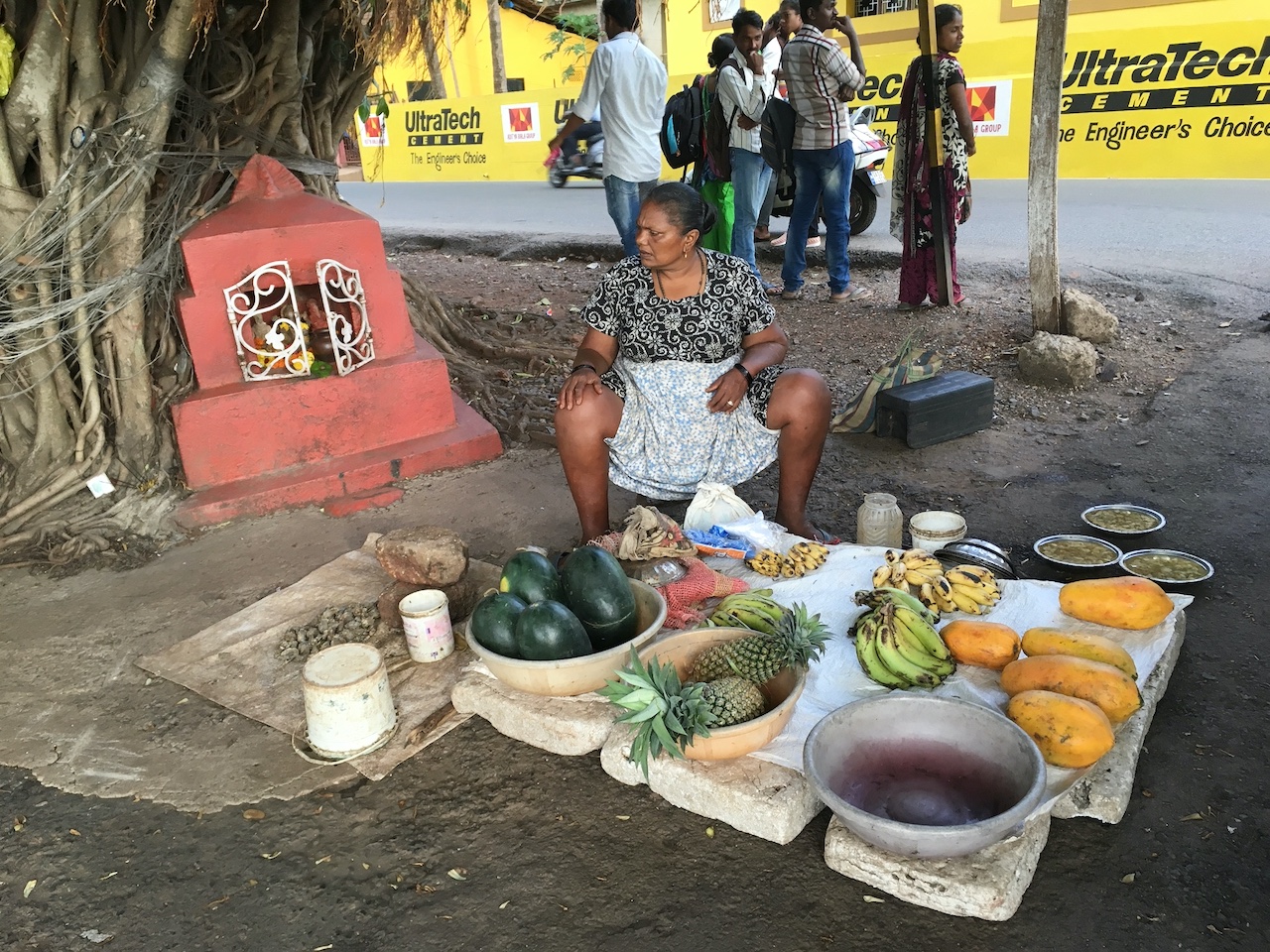
Roadside vendor in India. Photo: Zara Quiroga
When it comes to Goan and broader Indian influence on Portuguese food today, we can observe this is a history still being written, especially as modern chefs incorporate elements of international cuisines. Of course this doesn’t exclusively happen within businesses, but also within the family spectrum, namely in the households of migrant families and multicultural couples.
The same can’t be said about Goa or anywhere else in Índia, where our observation and research isn’t conducive for us to think that Portuguese influence is still alive and well in India. Of course the historical influence can still very much be felt around Goa, but as other Indians bring in their influences to this Indian state, changes to the Portuguese background will with time tend to get diluted. There’s no new considerable influx of Portuguese to India today and, while interest and purchasing power of the Indian middle-upper class does translate into eating more outside of the house, other world cuisines much more well-known to Indians (even from our neighboring Spain, but specially Italian, American, and other Asian countries) tend to be preferred over Portuguese. To the contrary of the sizable subcontinental community in Portugal today, the Portuguese community in India isn’t representative. Pair this with the general lack of knowledge of what Portuguese cuisine is about and the fact that Portuguese cuisine uses ingredients which aren’t widely consumed in India (like pork), and it’s easy to conclude that Portuguese food (not to be mistaken with Goan-Portuguese food) has little to no market appeal in India. An exception could be made in recent years with pastel de nata, not because of direct Portuguese influence in India, but simply because Portuguese custard tarts are increasingly trending worldwide. To taste these dreamy creamy cakes, we recommend visiting Nata Goa, (located in Anjuna). In this one state of India it still makes sense to label food as Portuguese because the historical link, which locals as well as most tourists are well-aware of, simply makes products immediately more sellable.
In this era of globalization and transnationalism, where new technologies also play an important role in cultural encounters and exchanges, the history of Goan-Portuguese cuisine is still being written. We believe the mixing of cultures is still happening and hasn’t stabilized yet, if it ever will! The world with all its cultures lives in a permanent state of fluidity which makes this kind of mingling and merging a phenomena with no end in sight.
A great example of contemporary luso-indian food is UK based restaurant Estado da India (in Birmingham), which further develops the concept of luso-indian cuisine and removes it from an old-day sometimes stagnant scene. We believe such concepts could work very well here in Lisbon, if not started by locally based Indians or Portuguese of Indian descent, brought to us by newcomers.
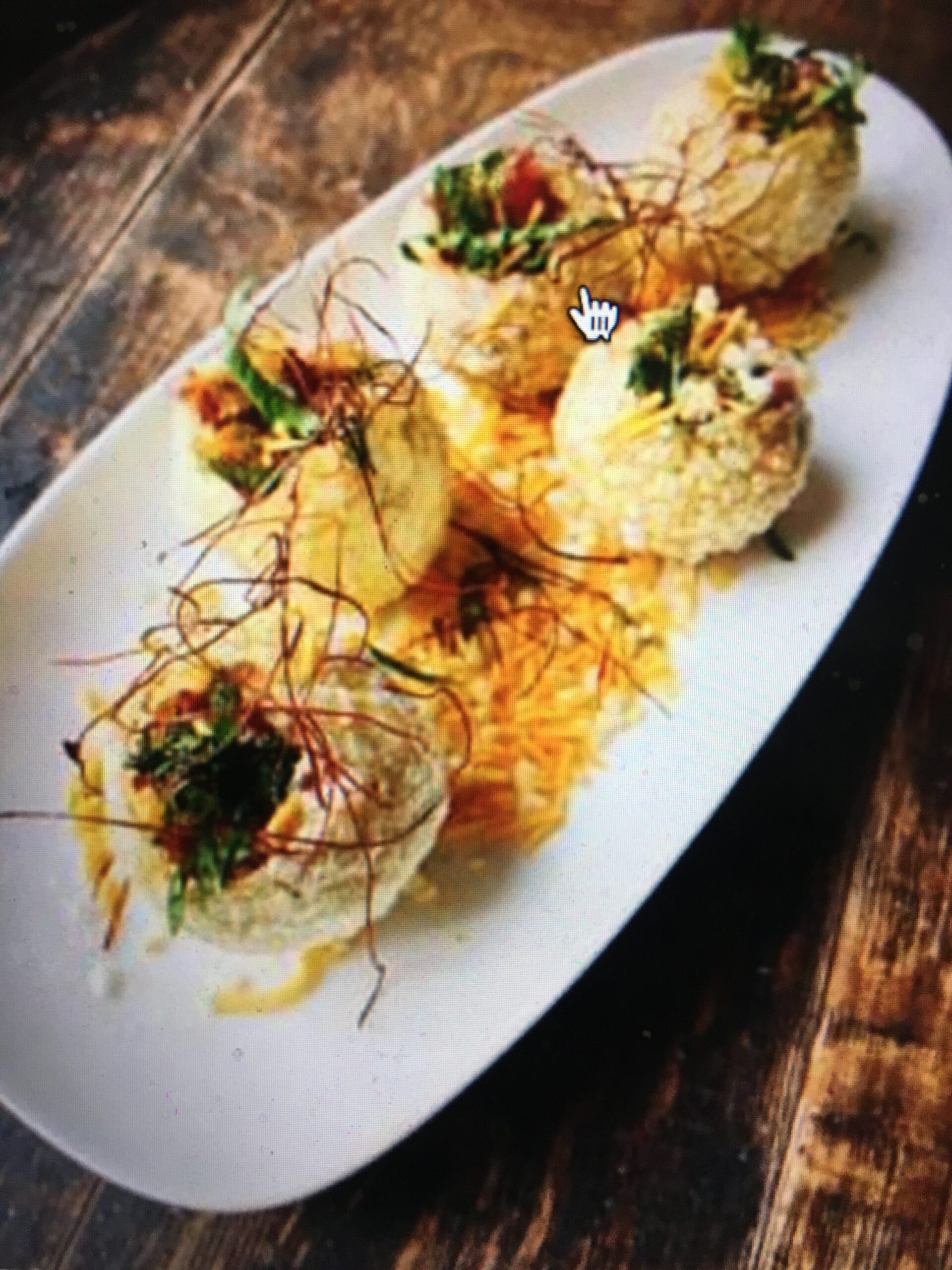
Mestre André creation (© Taberna da Rua das Flores)
As Goans have naturalized Portuguese and, because of that have been granted the right to live anywhere in the schengen area, it could also happen that they obtain experience abroad, perhaps breath in influences from other parts of Europe, and come back to Portugal to creatively expand the concept of Indian-Portuguese food. We can only say that we’re ready for it!
Transcultural cuisine
Dishes such as those mentioned above by Taverna da Rua das Flores’ chef André Magalhães are not only a tribute to our past, they are also a new form of cultural expression which embody the meeting and mixing of cultures.
We could be talking about the fusion of cuisines but, in many cases, the most appropriate term may just be transcultural cuisine rather than fusion cuisine.
Transculturalism (as an alternative to multiculturalism, cross-culturalism or pluralism) calls for more interaction and cultural exchange, promoting and allowing communication between cultures. Multiculturalism refers to culturally diverse societies as being a “mosaic” (where parts fit together into a whole, but boundaries are still well defined and stable). Transculturalism, which stresses communication, exchange, co-construction, creativity and transformation between cultures, replaces the concept of mosaic with that of a “kaleidoscope”.
Within this kaleidoscope, which is a result of migrations, post-colonialism, rise of countercultures, new technologies and other facts, multiple identities and societies are constantly being constructed and reconstructed. From the encounter of two cultures (or two people), a given third space originates. Indian scholar Homi BHABBA (1994) on ‘The location of culture’ refers to it as a potential space existing between these two poles. Bhabba also refers how, what was until then constructed by society as being at the margins (migrant population, the city skirts and so on) is, in fact, the epicenter of our cultural modern society, where new forms of cultural expression are constantly recreated and mixed.
Since food is one (very important!) form of cultural expression/communication (among so many others), societies keep being enriched by food cultures from all over the world. And this is why cuisines are ever changing concepts, which do indeed have roots but are also allowed to shift with fluidity. Fluidity is how many authors define our era of globalization and transnationalism. And even if we do not totally agree with concepts like ‘liquid identity’ (Bauman, 1997), we consider that they do reflect the emergence of a different social paradigm in our societies.
In this context eating is much more than a pleasure and a necessity for biological survival!
As we saw, food is also the gateway to local and global history. It is the way to express counter narratives, power relations, social changes, migrations and even gender roles.
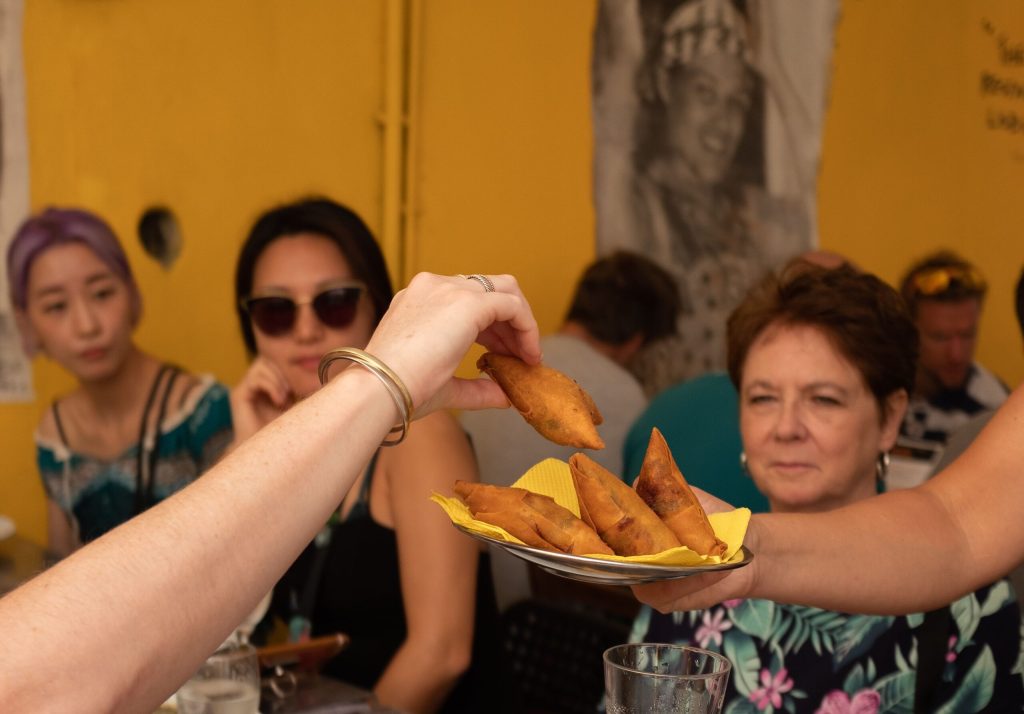
Samosas being served during one of our ethnographic food tours
Article by :
Zara Quiroga (freelance food writer and food & cultural leader at Oh! My Cod Pico Trips)
Sílvia Olivença (anthropologist and food guide/CEO at Oh! My Cod Ethnographic Food Tours & Trips)
Want to more about Portuguese cuisine and its influences?
How Portugal influenced Indian cuisine
Alentejo and Algarve: culinary traditions of the South of Portugal
10 Portuguese Codfish recipes step-by-step
Minho, Douro and Trás-os-Montes: the cuisines of Northern Portugal (includes Porto!)
